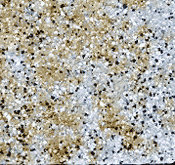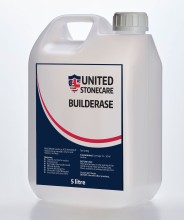
Removing Rust Staining from Internal and External Stone Paths and Patios
It is essential that you understand which stones can be treated with acidic products in order to remove rust and which cannot. Please read the following and contact us if you have any queries. Always do small test areas first. Read all product instructions. This is YOUR responsibility.
Understanding Iron Oxide (Rust) Staining
Some stones such as granite, slate and sandstones can become discoloured due to a natural iron content oxidising (Rusting). This can cause brown marks or, in the case of grey or black granite, dark patches.
A common cause of this issue being rapid and / or severe is the use of hydrochloric acid contained in brick and patio cleaners. Never use these products on natural stone.
Another common cause of small, brown rust marks is the use of lawn feed and weed type products. These contain ferrous sulphate which can cause marks; do not leave the pellets on your stone!
Rust marks can also be caused by rusty water running off iron or steel tools, furniture or fixtures that are rusting.
On acid resistant stones such as most sandstone, most granite and most slate where the staining is not too severe, use Builderase. In additon to reading all of the instructions on the product page, the following guidance will help you:
- Start on a small, inconspicuous area.
- Do not work in bright sun on a hot day. It should not be raining either.
- Damp the stone first (no puddles, just damp stone).
- Use Builderase diluted at about 1:3 with water.
- Apply enough to wet the stone where the rust stain is present.
- Keep it wet with solution for between 30 minutes and two hours and monitor progress.
- Note that you will NOT see "rusty water" coming from the stone. Instead, the rust mark will fade.
- You can repeat the process once or twice if required.
If the staining is severe on the above, acid resistant stones, and Builderase is not working well enough you can pre-treat with Gel Rust first.
- Apply Gel Rust directly from the container onto the area of the rust mark.
- Gently distribute with a brush.
- You will see the product turning a very dark purple colour within a few seconds which confirms it is reacting with the rust. If there is no purple colour the stain is NOT rust.
- Keep enough Gel Rust on the surface to be liquid and agitate gently.
- Leave on the surface for 5 to 10 minutes and then rinse thoroughly. It is best to use running water and a brush to agitate whilst rinsing.
- If you leave Gel Rust on too long you could leave a purple tint. However, in our experience this has never happened.
- Once the Gel Rust treatment is finished the remaining rust is usually easy to remove with Builderase.
For Rust Marks on acid sensitive stones such as limestone, marble and travertine and all cement based surfaces you can use Gel Rust.
- Apply Gel Rust directly from the container onto the area of the rust mark.
- Gently distribute with a brush.
- You will see the product turning a very dark purple colour within a few seconds which confirms it is reacting with the rust. If there is no purple colour the stain is NOT rust.
- Keep enough Gel Rust on the surface to be liquid and agitate gently.
- Leave on the surface for 5 to 10 minutes and then rinse thoroughly. It is best to use running water and a brush to agitate whilst rinsing.
- If you leave Gel Rust on too long you could leave a purple tint. However, in our experience this has never happened.
- You can repeat the application as required.
Do NOT use Builderase on acid sensitive stones.
For all instances of rust staining, DO A DEMO AREA FIRST.
If you require additional assistance, please contact us.
Don’t want to Do-It-Yourself? We can do the work for you or put you in touch with a contractor
Ask us a question or send us a picture of the problem and we will give you the benefit of 30 years of experience

